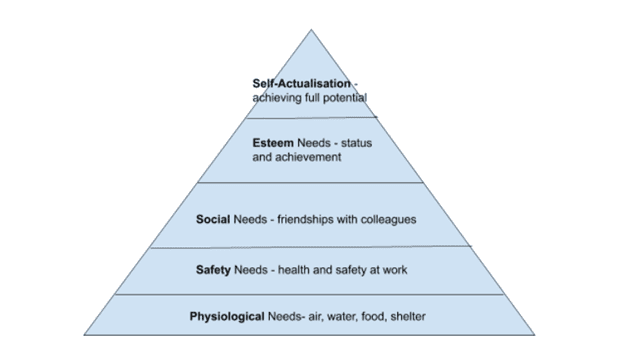2.1.1 The Importance of a Well-Motivated Workforce
Why people work and what motivation means
Motivation is the reason why employees work hard and effectively for a business. Why is it so important for a business to have motivated employees?
Motivation improves productivity so motivated workers will work harder and produce more output, and the firm will make more profit as a result.
Labour productivity is output per worker measured by output divided by the number of workers. So if 10 workers pick 4000 oranges the labour productivity is 4000 divided by 10, 400 oranges per person.
Motivated workers will arrive on time, are less likely to be absent from work (also known as absenteeism) and are less likely to leave the business. We can calculate the rate at which workers leave the business by dividing the total number of employees by the number of employees who left in the last year.
|
Labour productivity = Output per worker No of workers Labour Turnover Rate is the amount of employees leaving a business in a year and is calculated as a share of the total workforce |
But it’s not just the quantity it’s the quality of the output. Motivated workers are an asset who will go the extra mile for their business. Some examples of highly motivated employees include: a sales assistant who makes every customer feel special; an engineer who works additional hours to make sure the product development is just right; a teacher who always has time to answer student queries.

Motivated workers make the workplace a fun, positive environment where people want to be.
On the other hand demotivated workers are a liability for a business, and can mean an unsatisfactory customer experience, where products are faulty or the service is inadequate. Demotivated workers are a negative influence on co workers and bring down the whole morale of the workforce, impacting the long term success of the business.
Therefore, motivation is hugely important in a firm’s success, so how do we motivate workers?
The simple answer is that there is no simple answer. Workers are people, who are all individuals and have different needs from work. However, this hasn’t stopped motivational theorists from trying to figure it out.
Key motivational theories: Maslow, Taylor and Herzberg
Taylor is the original motivational guru and his ideas were hugely influential during the early 20th century, at a time when many factories were moving to mass production.
He came up with the idea of scientific management: observing employees, figuring out “one best way” of completing a task, and then training all employees to do the job exactly the same way. This had a huge impact on improving worker productivity at the time.
Taylor’s theory on worker motivation was that the more you pay workers, the harder they will work and the greater the output will be produced. Therefore, he argued it was best to pay workers by piece rate. If you paid them more by how much they produced, they would work harder and output would increase.
However, his approach just focused on one human need, money (financial rewards). It ignored other human needs like social needs (being able to form friendships at work and feel part of a team) and achievement, feeling your work has meaning and you have contributed to something bigger.
Fast forward 50 years to Abraham Maslow. He believed money was important in that it fulfilled a need to provide food and shelter, but he also believed humans had other needs and wants which needed to be satisfied before employees became fully motivated. He ranked them on his now famous pyramid also known as the hierarchy of needs.
First physiological and safety are the most basic needs, then social, then esteem needs – feelings of achievement, respect or status. The peak of the pyramid is self-actualisation when employees have reached their absolute full potential.
Maslow’s Hierarchy of Needs

Herzberg refined the pyramid with his two factor theory. He said that employees need certain basic needs, called Hygiene Factors, to be fulfilled by the business before they could even begin to think about motivation.
Only after the Hygiene factors (like working conditions and wages and salaries) had been taken care of, could employees be motivated using achievement, recognition and responsibility.
|
Motivators Will motivate employed after hygiene factors have been satisfied |
Achievement Recognition The work itself Responsibility Advancement Growth
|
|
Hygiene Factors Must be achieved before workers can be motivated |
Company policies Supervision Relationship with supervisor and peers Work conditions Salary Status Security |
So what do we need to know about Maslow, Herzberg and Taylor and motivational theory? It gives us a good background understanding of all the different factors which combine to motivate employees. However, specific questions on any one of the theorists are not common. A much more likely exam question is: what practical steps can leaders and managers take to motivate employees? We will find out next.
2.1.2 Methods of Motivation
Methods of motivation are broken down into two categories: financial and non financial.

Financial Rewards
Wages are usually paid weekly and are calculated by how many hours an employee works, times their hourly rate, or how much is produced by a worker in a factory, piece rate. This sort of payment is often used with lower skill workers or part time employees.
Wages allow flexibility for employees and business, but may lead to feelings of job insecurity in employees as they can’t be sure how much they will be paid every week.
Salary is a fixed payment every month. Often used for higher skill professional jobs like teachers or managers. In these jobs it may not be possible to use time rate or piece rate. Unlike wages, employees feel greater job security in employees as they can be sure how much they will be paid every month.
However, it can lead to complacency in employees, so businesses may need to consider additional methods of motivating staff.
A bonus is usually a one off reward. It could be for achieving a target like a driver delivering all his parcels accurately and on time. It could also be a team reward like a factory increasing production by 20%. Bonuses gives employees a target to work towards, but they can be costly for the business
Commission is a kind of bonus where salespeople are given a percentage of the selling price if they make a sale. If a car salesperson gets 1% of selling a $30000 car, he/she will receive $300. So this should encourage higher sales. But it may lead to over pushy salespeople, who force customers to buy the most expensive products rather than what is most suitable.
Profit sharing is when employees get rewarded with a very small % of the firm’s profits annually. In 2020 SouthWest Airlines shared 12% of $700 million profits giving each employee $1400.
It encourages a team spirit as all employees will want to make the company successful to earn more profit
However, with all team benefits there is the free loading problem where some individuals may be working harder than others but all employees are rewarded by the same amount.
Non Financial Rewards
Job rotation is when employees switch simple tasks for a short time. Workers in McDonald’s could swap positions between grilling burgers, cooking fries or wrapping finished products. This will make the job more interesting than continually doing a repetitive task, but as the work doesn’t involve much additional responsibility or skill it is unlikely to have a huge impact on long term motivation.
Job enrichment is when employees are given additional responsibility in their day to day tasks which often requires more training and or development. For example, a worker in a supermarket responsible for restocking the shelves, may be given responsibility for reordering inventory and handling all customer queries in this area. This will give further motivation than simple job rotation, as the employee feels like they are developing their skills and has a sense of achievement. The additional training and reorganising of job roles may be costly for a business, at least in the short term.
Team Working is when a group of employees are given responsibility for a specific project, department or unit of work. This allows greater interaction by fulfilling social needs. As employees work together to achieve a specific goal it gives workers a feeling of much greater job satisfaction and accomplishment.
However, it means managers have to delegate responsibility to the team, and find ways of changing work processes to allow team working.
Training develops workers’ skills. As it involves considerable investment by a business employees will feel valued and will see the benefits of staying with the business if they will receive further training in the future. However, training is costly and there is always the chance employees will leave the business after receiving training.
Opportunities for promotion Firms can reward employees by giving employees another job in the business with higher status, pay or responsibility. Employees will be highly motivated to show leaders they should be promoted. Unless a business is expanding very rapidly or has high labour turnover, there will be limited positions available for promotion so it may not motivate all employees.
Recommend and justify appropriate methods of motivation in different circumstances
You may face a longer question where you have to consider the advantages and disadvantages of different methods of motivation.
Think about these points for making your decision:
– Is there evidence in the case study which shows what is currently demotivating the employees?
– Which motivational methods are suitable? Commission may not be suitable if the employees are not involved in sales
– As we learned with the motivational theorists there is some debate over the importance of money or financial rewards in motivating employees. Pay is important, but financial rewards alone won’t be enough to ensure all workers are motivated.
– Cost? Can the business afford to give all the employees a pay raise? Can they afford enough to make a difference?
Remember with evaluation you need to make a decision, justify why your choice is more suitable than the other options for this business.
People in Business Interactive Activities

